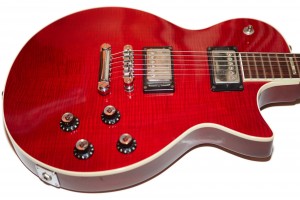
The Guild bluesbird of this era is quite clearly inspired by the Gibson Les Paul, but there are some important differences. First, and perhaps most important, the Bluesbird is chambered which makes it lighter than the average Les Paul while also making it more resonant with a more open sound. The shape is a bit different, and Les Paul purists will likely rebel against that, but for me, it’s every bit the guitar that even an Historic Les Paul is. Let’s find out why, and talk about some of the differences between the Guild Bluesbird and a Gibson Les Paul.
Finish
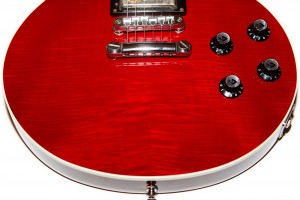
It’s almost a shame that this beautiful top was covered in red as it would have made a stunning sunburst.
There are no factory flaws in the finish. No thin spots, no drips, and not even any dings from 20 years of use.
Fretboard and Neck
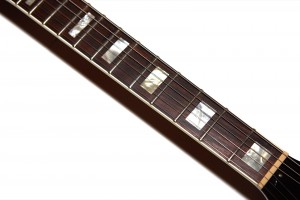
The neck is typically straight on this guitar, and as I’ve written before, I don’t think I’ve ever had to adjust the neck on any Guild I’ve owned. I did have a Guild JS-65-12 that needed a neck reset, but if you held the tension of 12 guitar strings for 25 years, you’d need a neck reset, too.
Some Bluesbirds have very beefy necks (usually the P90 models), but this one is nice and solid without feeling like the fat end of a baseball bat. I like necks to be on the fatter side, and this one delivers without feeling like a real handful. The nut width of 1 11/16″ seems to be standard on all Guild electrics from this time period, but this guitar actually measures 1 23/32″ which is halfway between 1 11/16″ and 1 3/4″.
The frets are excellently finished, and they don’t have those little nibs over the ends that Les Paul Historics have. I’ll be honest here in that I think the binding nibs are not my favorite feature, so in this regard I greatly prefer the Bluesbird.
Build Quality
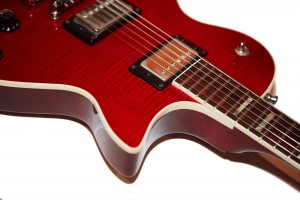
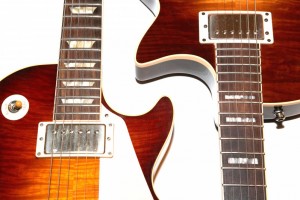
I should point out that the cutout on a Bluesbird is quite different than that of a Les Paul, a fact which Les Paul owners immediately notice and complain about. The Les Paul has a more curved cutout that tends to look “right” to anyone who’s stared at posters of Jimmy Page or Slash for too long in their youth. Functionally, it’s a cut out in the body of the guitar that lets your fingers access the upper frets, which it does.
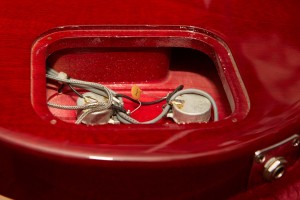
Pickups
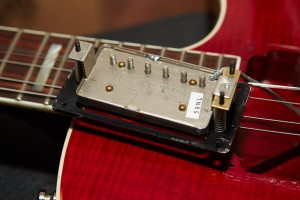
For the curious, Guild Bluesbirds are actually routed to fit the vintage HB1s, and will also take the new HB1s, should you be so inclined. I don’t see the need on this guitar, but I did it with another Bluesbird a few years ago with great results as seen in the pics.
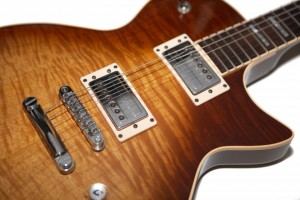
Electronics
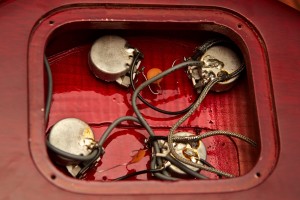
Hardware
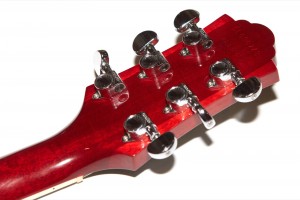
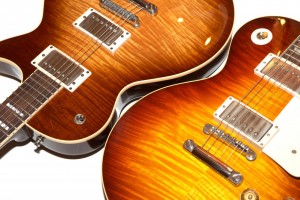
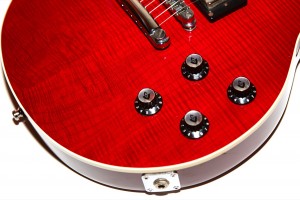
The knobs on Bluesbirds are often clear plastic (which I dislike), but the red Bluesbird came with the more archetypal black Guild knobs which I love.
The guitar comes with a black pick guard, but was not installed at the factory (yay!), so the option of drilling into the top is left up to the buyer. Of course, being a 20-year old model, finding one without the pick guard installed is a matter of chance.
Sound
My favorite electric guitar of all time is my Guild Nightbird with vintage HB1 pickups. This Bluesbird guitar is surprisingly close to my coveted Nightbird in sound, and I’ll be honest, that surprised me. This guitar sounds great! Plugged into my Axe-FX with the JCM 800 patch, this guitar demands to be played loudly. With a cleaner amp, it’s still fun to play with a great tone.
You can certainly hear the chambers affecting the sound which may be what Les Paul purists dislike about the tone, but I really like the complex tone delivered by the Bluesbird. That’s not to say that I dislike Les Pauls – far from it! For the money, though, I could have multiple Bluesbirds for the price of one Gibson Les Paul.
Les Paul aficionados correctly state that a Bluesbird does not have that Les Paul Sound, but let’s be honest here; the subtleties between a Bluesbird sound and a Les Paul sound are lost on audience members that just want to enjoy the performance. If I play “Still got the Blues for You” on stage with a Guild Bluesbird, how many people in the audience will complain that it’s not a Les Paul? I’ve played rockabilly on stage with an orange Guild X-170T after which people came up to me and told me that they loved my Gretsch.
For those who insist that only a Les Paul can sound like a Les Paul, consider the fact that Billy Gibbons uses an EQ to make all of his guitars sound like the famed Pearly Gates Les Paul. This is shown in the excellent Rig Rundown by Premier Guitar shown to the right. It’s worth a watch all the way through (my link starts eight minutes in), but be warned that the drum check going on in the background is maddening.
I really like the distorted sound I get from this guitar, especially with the typical amp setups used with a Les Paul or other humbucker guitars. There’s something about a great sounding guitar through a great sounding amp that just makes me want to bang on chords and let them ring out for the world to hear, even if I’m not good enough to play it right. You know, according to the neighbors.
Playability
This guitar plays as well as my Nightbird! Well, maybe not quite that good, but it’s pretty darn good. Considering the law of diminishing returns, this guitar crushes the Nightbird when it comes to cost vs. performance.
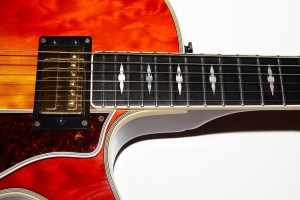
This particular guitar does not have the super-thick necks associated with the R8 and to a lesser extent, the Les Paul R9s, but it is not shredder-thin, either. Online, I see a lot of Les Paul purists state their dislike for the Bluesbird necks. Having owned a lot of guitars over the past 40 years or so, I’ve learned to adapt to almost anything. The only necks I really dislike are the super-thin shredder necks and the really thin “pencil” necks found on many ’70s era guitars (Guilds included).
Conclusion
Will this guitar convince a rabid Les Paul fanatic to switch? Probably not. Is it all the guitar you need if you can’t afford the ridiculous prices Gibson is asking these days? Hell yes. Not only that, but in my opinion these late ’90s Guild Bluesbirds are far better guitars than the regular Les Pauls being pumped out by the thousands for well over $2500 new. The problem for someone who wants a Les Paul is that these guitars don’t feel like Les Pauls, especially the Historics.
These late-’90s Bluesbirds are really nice guitars that should be selling for far more on the used market than they do. I think the only reason they’re not is because Jimmy Page never played one. Personally, I think that’s great because it means I can buy them up for a song. I loved my Historic Les Pauls, but this guitar works just as well for me and I’m not freaked out every time I take it out because I don’t have $5000 tied up in it.
If you’ve ever considered a Bluesbird, I recommend that you try one. I bet that your fingers and your ears will tell you to buy it.
Donate: PayPal Crypto:
ETH: 0x0AC57f8e0A49dc06Ed4f7926d169342ec4FCd461
Doge: DFWpLqMr6QF67t4wRzvTtNd8UDwjGTQBGs

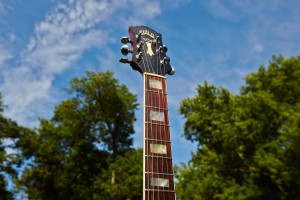
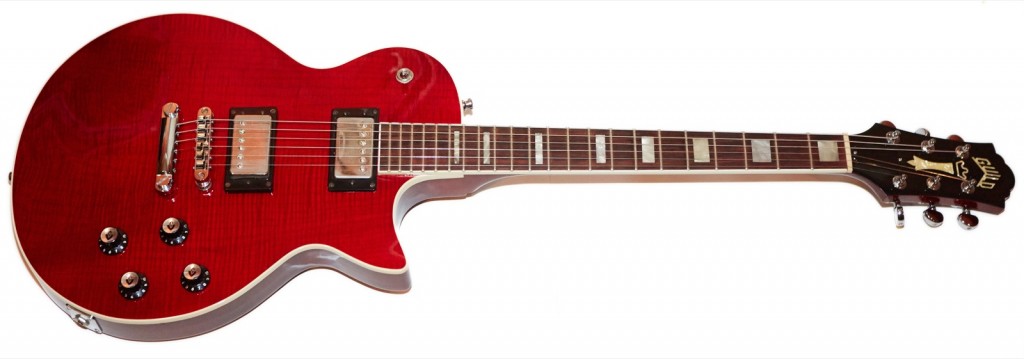
Great purchase, I’ve had a tobacco burst Bluesbird (AAA top) since 2001 and a red (same ‘red’ as yours) Blues 90 since 2010. I remember seeing a Blues 90 (in a deep translucent green) in Leeds UK in the late 90s and always fancied one (to add to the collection as this includes a 1979 Guild B301 fretless bass). So job done and the P90s and chambered body IMHO sound even better.
However, the vibrancy and transparency of the Bluesbird sound gets me every time, especially when i have jammed with colleagues with guitars including their PRS. The Guild looks fantastic and is very comfortable weight wise with the chambered body. I love the fact its left field, of the default choice LP. I have grown up with Les Pauls, slung over the shoulder of my heroes, so i am an LP fan, but don’t have one. I
On the Guild i love the fat transparent knobs (though love the top hat golds on my 25th anniversary Explorer too.) Yes its possible to appreciate both !! My own query re the Guild would be tuners which i have always felt needed to hold tune a bit more firmly, esp the g string…though no major complaints. i recently upgraded the tuners on my Ibanez PS120 as i wasn’t to too impressed with these.
So to conclude well done, great pictures, would bite the hand off, for a late 90s Guild Starfire single cutaway in natural, but that’s for another day.
I own 2 1997 blues birds and they are both fantastic works or art that play and sound outstanding. I also own a 45 year old les Paul. The lp has monster tone but is nowhere near as easy to play as my guilds and weighs in at over a full pound more.
Your post was spot on. I second the nod on the late 90’s westerly bluesbirds.
I have a 96 Goldtop LP Limited Edition (whatever that means) I really like it. It’s a great guitar It have a really nice neck on it. It sounds just like it should. It is heavy though.
I also have a red Guild B.B. from Westerly. It’s a different guitar. Everything in this article is correct. It isn’t a Les Paul. It isn’t supposed to be. I think it sounds better than the Lester for some sounds. These guitars are both at the same level in sound and manufacture, one isn’t better than the other. If I had to get rid of one it would probably be that Goldie. It would be done because I needed cash and I could get a lot more from it than the bird. The could stand in for each other with no problem. The author is correct the only people who would care in the audience are the gear head L.P. fans. I’d bet that most couldn’t tell the difference through and amp with overdrive and other devices.
I started obsessing looking for solid guitar that’s feels cheap and I found your forum .You have very comprehensive coverage of bluesbird. Hope I find one what’s a fair price for 1997 bluesbird